|
==============================================================================
TOPIC: Washington DC: Trees Surrounding the Reflecting Pool
http://groups.google.com/group/entstrees/browse_thread/thread/c01f90f596ef83f8?hl=en
==============================================================================
== 1 of 1 ==
Date: Tues, Apr 8 2008 4:45 pm
From: Matthew Hannum
Greetings, fellow ENTS!
The last weekend in March I decided to head on down to Washington DC
to see the cherry blossoms in bloom. The weather cooperated - only
clouds and no drizzle or rain for a change - and the cherry trees
were
spectacular. While I was there, I took some time to head over to the
Lincoln Memorial to better document the massive trees that line the
two paths on either side of the Reflecting Pool.
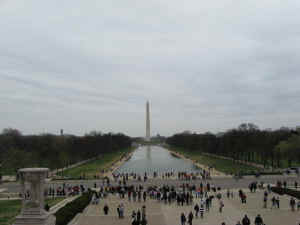 Reflecting Pool
Reflecting Pool
For those who may not be familiar with this part of Washington DC,
the
Reflecting Pool lies closer to the Potomac River, past the
Washington
Monument, and before one gets to the Lincoln Memorial. Two walking
paths of good size are on either side of it, and each path is shaded
on both sides by a large number of trees. Many of the trees are of
mixed age and species, but the oldest trees are the focus of this
article. The best view of these two rows of trees is from the steps
of
the Lincoln Memorial towards the Washington Monument.
The oldest trees along these two paths are American Elms, which
surprised me at first given the devastating effects of Dutch Elm
disease upon this species. No doubt the Park Service takes great
time
and care maintaining these trees, and they seemed to be in good
health
when I visited.
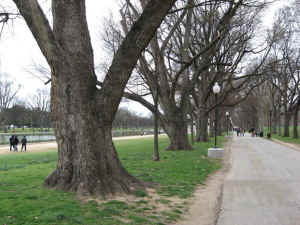
Ancient Way
The largest of these trees are about 6-feet in diameter at 4.5-feet
above the ground, though trees that did not branch as low are
somewhat
smaller. Height-wise, it is hard to say, but I seriously doubt any
of
them even approach 100-feet. Many of the trees in DC tend to be
stout
and spreading, and I suspect the winds that are often felt in the
city
have that effect.
What is particularly interesting about these trees is that in
addition
to being good examples of large and healthy American Elms, they can
be
accurately dated without needing to core the tree. The entire area
of
the DC Mall made up of the Reflecting Pool and the Lincoln Memorial
was underwater about 100 years ago. The Potomac River was dredged
after the turn of the last century and new land was created for
these
monuments. The Lincoln Memorial was established on May 30, 1922, but
the first stone was laid in February, 1914 (source: Wikipedia.)
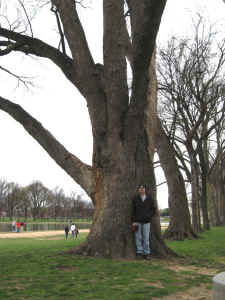
Matthew Hannum and huge Elm trees
While I do not know when exactly the Elm trees were planted, it is
safe to say that they were probably planted no earlier than 1914.
So,
doing the math, even if one assumes the trees were planted in 1914
and
were several years old when planted, the trees still are almost
surely
less than 100 years of age. It is also safe to assume (based upon
old
maps and images of the Lincoln Memorial when it was new) that the
trees were in place by the time the Lincoln Memorial opened in 1922,
so they are probably around 90 years of age. Without this historical
knowledge, one would probably assume the trees were considerably
older
(150+ years) based upon their impressive size; these Elms are a good
example of just how large and fast trees can grow if given good
growing conditions and if properly cared for over the years.
While the paths may at one time have been lined entirely with Elm
trees, there are now several other species mixed in: it was
difficult
to ID much of anything since the trees had not yet put out any
leaves
(the buds on some were just opening), but there were definitely some
oaks in the group, and probably a few others species as well based
upon the differing bark, growth forms, etc. Ages of the trees range
from the near-100 years of the old Elms to some small, young trees
planted in the past few years. It is difficult to judge the health
of
trees when not in covered in leaves, but most of the trees seemed to
be in good health: no obvious injuries, signs of decay, poor care,
etc. I did see one relatively recent stump of a cut-down old Elm
tree:
there was no way to be sure what did it in, but the stump was not
hollow at the core, which is interesting.
So, the next time you are down in DC, take a walk to the Lincoln
Memorial and enjoy what may be one of the largest collections of
big,
old American Elm trees that is open to the public anywhere in the
nation.
==============================================================================
TOPIC: Washington DC: Trees Surrounding the Reflecting Pool
http://groups.google.com/group/entstrees/browse_thread/thread/c01f90f596ef83f8?hl=en
==============================================================================
== 1 of 3 ==
Date: Wed, Apr 9 2008 3:44 pm
From: "Will Blozan"
Matthew,
I read with pleasure your trip reports of my "native"
home. The first tree
company I worked for in MD was owned by an arborist who used to work
with
the National Park Service and cared for the elms you describe and
also the
White House and Capital grounds. He has some stories of ornery past
presidents and first wives!
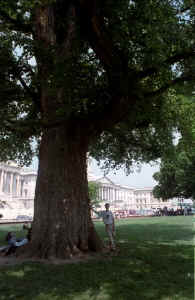
English elm 18'+ (didn't measure the girth- some drunk dude passed
out on
the other side...)
I find the trees of DC and vicinity quite impressive. Behind the
Capital are
some HUGE English elms, too. The common persimmon near the Capital
is
likewise huge and one of the finest I have seen. I think the
absolutely
massive willow oak is gone now; it was by far the largest I have
ever seen!
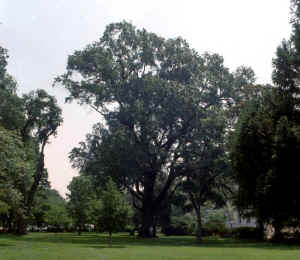 |
 |
20' willow oak US Capital Grounds ca. 1996
Will
== 2 of 3 ==
Date: Wed, Apr 9 2008 6:00 pm
From: Matthew Hannum
Nice photos, Will! I'll have to see if I can find that old Willow
Oak
again. If it is sadly gone, the mantle falls on the huge Willow Oak
near the "Grotto" on the Northwest side of the Capitol
Building.
Taking care of the trees around the Capitol is probbaly an ENTS
dream
job!
I haven't been around to the far side (side facing away from the
Mall)
of the Capitol since that area often seems to be either under
construction or otherwise blocked off - maybe it is accessible at
this
point, I hope. I did see one huge English Elm along the side of a
street on the north side of the Capitol. It wasn't in the best of
health and suffered some serious pruning, but it was big. There was
also a huge beech tree of perfect form in that area as well. I'll
have
to dig up some photos for a future post on other assorted trees in
the
DC Mall area.
== 3 of 3 ==
Date: Wed, Apr 9 2008 7:29 pm
From: "Darian Copiz"
Matthew, Will,
I'm not sure if either of those trees is still standing. There has
been
construction for the new visitor center in the vicinity of both of
those
trees for a while now - and they may be gone. The Architect of the
Capitol
actually has (or had) a table in his office that was made from the
stump of
an elm that was growing on the Capitol grounds - a pretty massive
one.
There's an even bigger willow oak (although maybe not as tall) at
the
National Arboretum in D.C. I'm also familiar with the elms near the
Lincoln
Memorial. I've tried ID'ing them before, but didn't come to what I
felt was
a solid conclusion. My guess was that they might be Dutch elms, but
I
wasn't certain. There are actually quite a few very impressive
American
elms in D.C. Many of these have massive trunks with beautiful crowns
consisting of branches twisting in picturesque contortions. Most of
these
are street trees, but there are some big ones in people's yards and
in some
natural areas as well. That reminds me, I've been wanting to start a
big
tree list for D.C. As far as I know, it's the only land in the U.S.
that is
not covered by a big tree list. We also aren't represented in the
Senate or
Congress, but we pay taxes just like the rest of the country.
Arguably we
have the best license plate in the country, which states
"Taxation Without
Representation." Well that's getting off subject, but we also
have big
trees with no representation. I've been tied up with other projects,
but
hopefully I'll get around to representing D.C. trees sometime soon.
Darian
== 3 of 4 ==
Date: Thurs, Apr 10 2008 12:01 am
From: Beth Koebel
Darian,
I found an inter-active map of big trees in Washington DC. It is at
http://www.caseytrees.org
Beth
== 2 of 3 ==
Date: Thurs, Apr 10 2008 5:37 am
From: Matthew Hannum
Interesting:
I looked over the Casey Tree web map of the area, and almost all of
the Elms on the north side of the Reflecting Pool are labeled as
Dutch
Elms, while the ones on the south side are labeled as American Elms.
Could that really be the case? Well, either way - the area
surrounding
the tidal pool is an excellent example of large, old Elm trees, and
there are certainly some American Elms in the group. Based upon
their
measurements, trees of 3 to 4 feet in diameter are rather common:
some
of them come in over 5 feet lower down on the trunk if one considers
the large root flares (though that is not an official measurement,
but
it does contribute to the visual mass of the tree.)
I think I was mistaken about there being other species mixed into
the
actual double rows of trees: It seems that they are all Elm trees,
and
the oak leaves I saw blew in from neighboring trees just outside the
double rows. It is interesting, however, that while the double rows
are apparently all Elms, many of the trees have very different
growth
forms, and even the bark changes significantly when comparing the
90-
year old monsters to considerably younger trees, giving the illusion
of different species when the trees are not yet leafed out.
== 3 of 3 ==
Date: Thurs, Apr 10 2008 4:13 pm
From: "Will Blozan"
Matthew,
One of the many tree jobs I did in the DC area in the late 1980's
involved a
full day job for three guys. We spent all day removing the lower 18
inches
of an American elm stump that was well over 10 feet across. I
remember lying
across it with arms stretched out after it was cut to grade and not
coming
close to touching the edges. We had to pour several gallons of oil
on the
chainsaw blade to keep it cutting in the wet, soppy wood. It truly
sucked;
as you may know dead American elm smells like dog crap and I was
saturated
with it. Very heavy, too.
Will
|